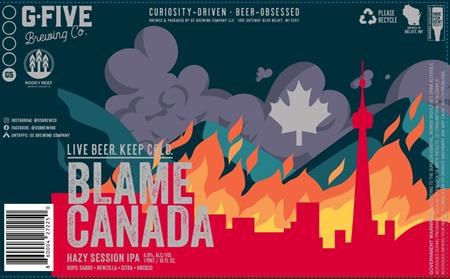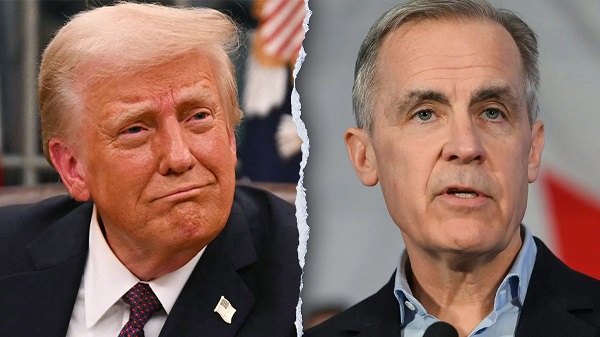Alberta
The latest legacy of Canada’s wildfire smoke? Wisconsin’s new beer-and-burger pairing

WASHINGTON — Another fragrant, hazy phenomenon is turning heads in the United States — only this time, beer fans in Canada will happily take the blame.
It’s one of the newest IPA offerings from G-Five Brewing Company in Beloit, a southern Wisconsin community of about 36,500 people an hour’s drive southwest of Milwaukee, a city synonymous with suds.
“Blame Canada” — what else would they call it? — is an easy-drinking session India pale ale inspired by the smoke-filled skies that were plaguing much of the U.S. Midwest and northeastern states earlier in the summer.
It was the product of a collaboration with fellow Wisconsin brewers Rocky Reef, a partnership that happened to come together in mid-June when the wildfire smoke was at its worst, said Tim Goers, G-Five’s head brewer.
“When you have a business that is cyclical like that, you don’t want your patrons to be outside because of air quality, so it does hurt business a little bit,” Goers said.
Naturally, that’s when the conversation turned to 1999’s “South Park: The Movie” and that now-anthemic song-and-dance number, “Blame Canada” — a riff on the show’s tongue-in-cheek fondness for making fun of Canadians.
“We were going to hold on to it for a week, but it was just dumb luck timing that the wildfire haze came back,” he said.
“We got to the point where when we kegged this beer up, it was pretty awful outside. We were, like, ‘It’s too coincidental — we can’t hold on to this beer.’ So we released it.”
That’s when it caught on like the proverbial wildfire.
Out of 12 available options on tap, “it’s our number 3 best-seller right now, and it hasn’t even had a full month of sales.”
Even the label on the can is one many Canadians could get behind — a red silhouette of the familiar Toronto skyline in flames, with a smoky mountain range and white Maple Leaf emblem in the background.
If the beer alone isn’t enough, patio patrons can pair it with G-Five’s latest Burger of the Week, “Canadian Wildfire,” a ground ribeye burger made with spicy maple syrup, the requisite back bacon, jalapenos and pepper jack cheese.
“If you have an IPA or a hoppier beer — ours aren’t, like, crazy hoppy — that will help cut some of the spice of the burger. So they actually ended up pairing really well together.”
Much of the U.S. is now getting a reprieve from the smoke, although there are still air quality issues in northern states including Montana, North Dakota, Minnesota and parts of northern Wisconsin, Environmental Protection Agency data shows.
Instead, most Americans will be contending this week with a fearsome heat wave that’s already punishing much of the southern U.S., with record-setting highs that are expected to reach 49 C in spots.
And Goers said he’s well aware that wildfire season on both sides of the border is only just getting started.
“It’s a tongue-in-cheek, fun thing for us as a brewery, but as a nation and for people that are going through it, it’s pretty awful,” he said.
“It’s kind of sad to me — I have a lot of empathy (and) sympathy for what the heck is going on … it’s the 14th of July, and typically the dry season hasn’t even started.”
G-Five used to source some of its malt barley from Maker’s Malt, a specialty producer near Saskatoon that caters specifically to the craft beer industry. But between the COVID-19 pandemic, shipping issues and recent droughts, the brewery has been forced to switch to a supplier closer to home.
“It hurts to see,” he said. “Now, does it hurt us brewing beer? No. But, you know, that’s not all my life is surrounded by.”
In the meantime, Goers said while he’s hoping the wildfires don’t flare up as badly as they did last month, G-Five will keep the “Blame Canada” recipe handy and break it out again if circumstances change.
“I’m not the biggest ‘South Park’ connoisseur — I might have watched a couple (episodes) in high school just so I could have something to talk about with my friends,” Goers said.
But if a Canadian craft brewer wanted to bat the ball back with a tart seasonal offering called “Team America: World Police,” for instance, he’d be all in.
“That would be hilarious.”
This report by The Canadian Press was first published July 15, 2023.
James McCarten, The Canadian Press
Alberta
Alberta takes big step towards shorter wait times and higher quality health care

From the Fraser Institute
On Monday, the Smith government announced that beginning next year it will change the way it funds surgeries in Alberta. This is a big step towards unlocking the ability of Alberta’s health-care system to provide more, better and faster services for the same or possibly fewer dollars.
To understand the significance of this change, you must understand the consequences of the current (and outdated) approach.
Currently, the Alberta government pays a lump sum of money to hospitals each year. Consequently, hospitals perceive patients as a drain on their budgets. From the hospital’s perspective, there’s little financial incentive to serve more patients, operate more efficiently and provide superior quality services.
Consider what would happen if your local grocery store received a giant bag of money each year to feed people. The number of items would quickly decline to whatever was most convenient for the store to provide. (Have a favourite cereal? Too bad.) Store hours would become less convenient for customers, alongside a general decline in overall service. This type of grocery store, like an Alberta hospital, is actually financially better off (that is, it saves money) if you go elsewhere.
The Smith government plans to flip this entire system on its head, to the benefit of patients and taxpayers. Instead of handing out bags of money each year to providers, the new system—known as “activity-based funding”—will pay health-care providers for each patient they treat, based on the patient’s particular condition and important factors that may add complexity or cost to their care.
This turns patients from a drain on budgets into a source of additional revenue. The result, as has been demonstrated in other universal health-care systems worldwide, is more services delivered using existing health-care infrastructure, lower wait times, improved quality of care, improved access to medical technologies, and less waste.
In other words, Albertans will receive far better value from their health-care system, which is currently among the most expensive in the world. And relief can’t come soon enough—for example, last year in Alberta the median wait time for orthopedic surgeries including hip and knee replacements was 66.8 weeks.
The naysayers argue this approach will undermine the province’s universal system and hurt patients. But by allowing a spectrum of providers to compete for the delivery of quality care, Alberta will follow the lead of other more successful universal health-care systems in countries such as Australia, Germany, the Netherlands and Switzerland and create greater accountability for hospitals and other health-care providers. Taxpayers will get a much better picture of what they’re paying for and how much they pay.
Again, Alberta is not exploring an untested policy. Almost every other developed country with universal health care uses some form of “activity-based funding” for hospital and surgical care. And remember, we already spend more on health care than our counterparts in nearly all of these countries yet endure longer wait times and poorer access to services generally, in part because of how we pay for surgical care.
While the devil is always in the details, and while it’s still possible for the Alberta government to get this wrong, Monday’s announcement is a big step in the right direction. A funding model that puts patients first will get Albertans more of the high-quality health care they already pay for in a timelier fashion. And provide to other provinces an example of bold health-care reform.
Alberta
Alberta’s embrace of activity-based funding is great news for patients

 From the Montreal Economic Institute
From the Montreal Economic Institute
Alberta’s move to fund acute care services through activity-based funding follows best practices internationally, points out an MEI researcher following an announcement made by Premier Danielle Smith earlier today.
“For too long, the way hospitals were funded in Alberta incentivized treating fewer patients, contributing to our long wait times,” explains Krystle Wittevrongel, director of research at the MEI. “International experience has shown that, with the proper funding models in place, health systems become more efficient to the benefit of patients.”
Currently, Alberta’s hospitals are financed under a system called “global budgeting.” This involves allocating a pre-set amount of funding to pay for a specific number of services based on previous years’ budgets.
Under the government’s newly proposed funding system, hospitals receive a fixed payment for each treatment delivered.
An Economic Note published by the MEI last year showed that Quebec’s gradual adoption of activity-based funding led to higher productivity and lower costs in the province’s health system.
Notably, the province observed that the per-procedure cost of MRIs fell by four per cent as the number of procedures performed increased by 22 per cent.
In the radiology and oncology sector, it observed productivity increases of 26 per cent while procedure costs decreased by seven per cent.
“Being able to perform more surgeries, at lower costs, and within shorter timelines is exactly what Alberta’s patients need, and Premier Smith understands that,” continued Mrs. Wittevrongel. “Today’s announcement is a good first step, and we look forward to seeing a successful roll-out once appropriate funding levels per procedure are set.”
The governments expects to roll-out this new funding model for select procedures starting in 2026.
* * *
The MEI is an independent public policy think tank with offices in Montreal, Ottawa, and Calgary. Through its publications, media appearances, and advisory services to policymakers, the MEI stimulates public policy debate and reforms based on sound economics and entrepreneurship.
-

 2025 Federal Election1 day ago
2025 Federal Election1 day agoResearchers Link China’s Intelligence and Elite Influence Arms to B.C. Government, Liberal Party, and Trudeau-Appointed Senator
-

 2025 Federal Election1 day ago
2025 Federal Election1 day agoRCMP memo warns of Chinese interference on Canadian university campuses to affect election
-

 Alberta2 days ago
Alberta2 days agoAlberta takes big step towards shorter wait times and higher quality health care
-

 Energy2 days ago
Energy2 days agoTrump signs four executive orders promoting coal industry
-

 COVID-1924 hours ago
COVID-1924 hours agoFauci, top COVID officials have criminal referral requests filed against them in 7 states
-

 Justice2 days ago
Justice2 days agoCanadian government sued for forcing women to share spaces with ‘transgender’ male prisoners
-

 Business2 days ago
Business2 days agoTrump raises China tariffs to 125%, announces 90-day pause for countries who’ve reached out to negotiate
-

 2025 Federal Election5 hours ago
2025 Federal Election5 hours agoWhat Trump Says About Modern U.S. And What Carney Is Hiding About Canada










